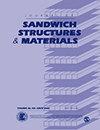Investigation of viscoelastic properties in composite sandwich panels subjected to low-velocity impact: Experimental and numerical approaches
IF 2.8
3区 材料科学
Q1 ENGINEERING, MECHANICAL
引用次数: 1
Abstract
This study investigates the effect of viscoelastic properties in the numerical modeling of foam-filled sandwich panels when their composite facesheets are exposed to low-velocity impact loading. A finite element (FE) model is developed using the software package of ABAQUS and used to investigate the effect of both considering and ignoring the time-dependent behavior of composite laminate facesheets as well as the foam core. Material constitutive equations, damage characteristics, and failure modes are defined in a FORTRAN user-subroutine VUMAT. To characterize the material behavior of both polyurethane foam and glass/epoxy composite material, a set of experimental tests are conducted under compression, tension, and stress relaxation modes. To validate the numerical results, low-velocity impact tests at two energy levels of 9.81 and 17 joules are carried out on sandwich panels with foam core. The results of numerical simulations are found to be in good agreement with the experimental test results. It is shown that ignoring the viscoelastic properties in the composite laminate and the foam core can lead to deviations of up to 7% and 25%, respectively, from experimental results. The analysis reveals that, ignoring the viscoelastic behavior along the fiber-direction in the composite facesheets does no change the results considerably. The viscoelastic properties perpendicular to the fibers, however, has a more noticeable effect on the results due to the prevalence of the properties of the polymeric resin in that direction.复合材料夹芯板在低速冲击下的粘弹性研究:实验和数值方法
本研究研究了当复合材料面板暴露于低速冲击载荷时,泡沫填充夹芯板数值模拟中粘弹性特性的影响。使用ABAQUS软件包开发了一个有限元模型,用于研究考虑和忽略复合材料层压板和泡沫芯的时间依赖行为的影响。材料本构方程、损伤特征和失效模式在FORTRAN用户子程序VUMAT中定义。为了表征聚氨酯泡沫和玻璃/环氧复合材料的材料性能,在压缩、拉伸和应力松弛模式下进行了一组实验测试。为了验证数值结果,在具有泡沫芯的夹层板上进行了9.81和17焦耳两个能级的低速冲击试验。数值模拟结果与实验结果吻合较好。研究表明,忽略复合材料层压板和泡沫芯中的粘弹性特性会导致与实验结果的偏差分别高达7%和25%。分析表明,忽略复合材料面板中沿纤维方向的粘弹性行为不会显著改变结果。然而,由于聚合物树脂在该方向上的性能普遍存在,垂直于纤维的粘弹性性能对结果有更显著的影响。
本文章由计算机程序翻译,如有差异,请以英文原文为准。
求助全文
约1分钟内获得全文
求助全文
来源期刊

Journal of Sandwich Structures & Materials
工程技术-材料科学:表征与测试
CiteScore
9.60
自引率
2.60%
发文量
49
审稿时长
7 months
期刊介绍:
The Journal of Sandwich Structures and Materials is an international peer reviewed journal that provides a means of communication to fellow engineers and scientists by providing an archival record of developments in the science, technology, and professional practices of sandwich construction throughout the world. This journal is a member of the Committee on Publication Ethics (COPE).
 求助内容:
求助内容: 应助结果提醒方式:
应助结果提醒方式:


